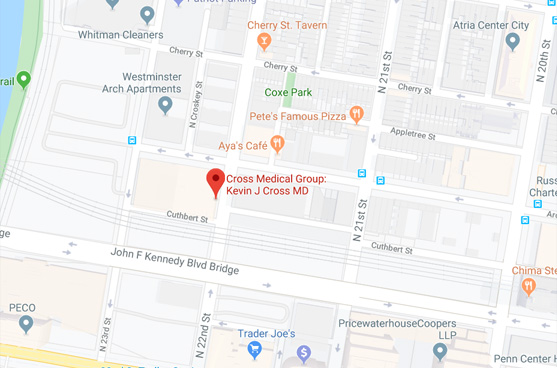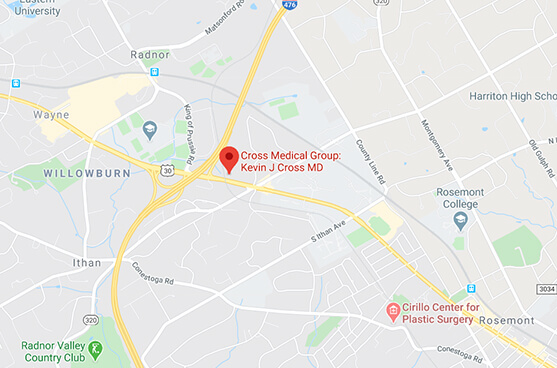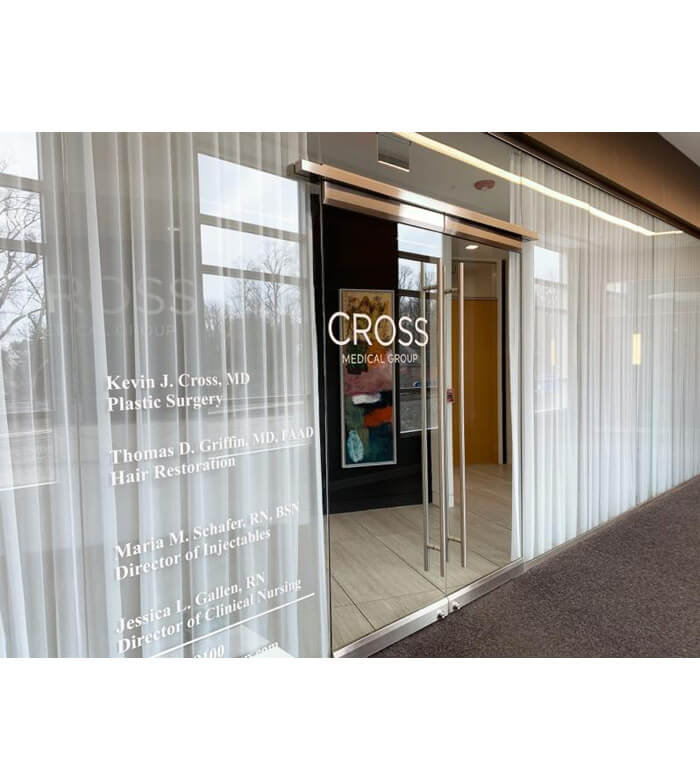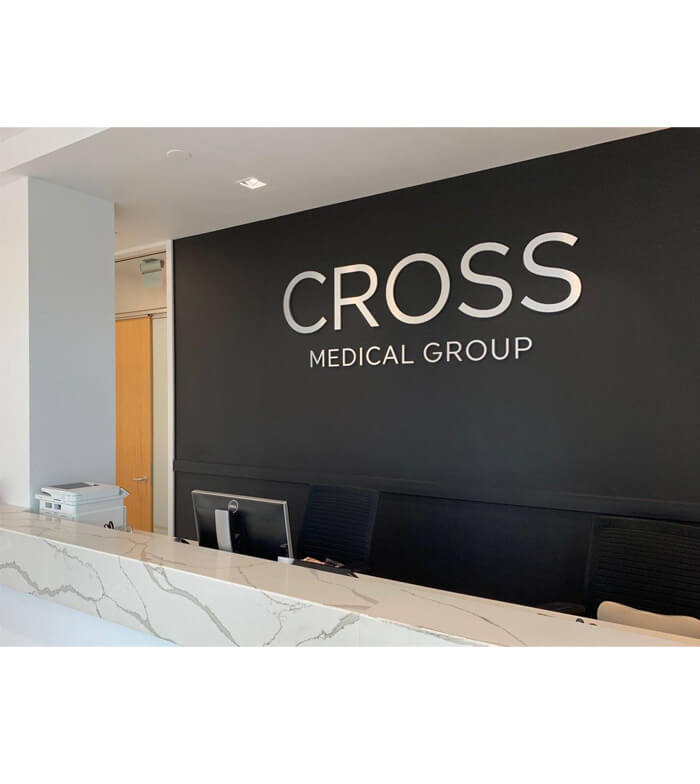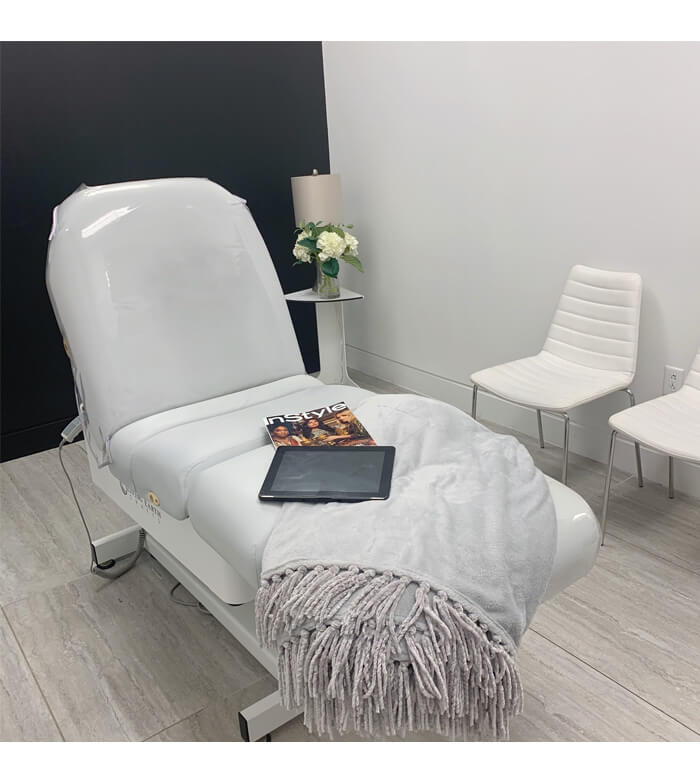Facelift
ENJOY MORE YOUTHFUL-LOOKING FACIAL CONTOURS WITH A RHYTIDECTOMY
Patients who want to address signs of aging on the face have many options available, but nothing compares to a facelift. The surgical procedure—known medically as a rhytidectomy—creates a more eOective and lasting change than possible with injectables, lasers, or other similar strategies. The accomplished Dr. Kevin Cross performs more than 100 facelifts and necklifts for patients from around the Philadelphia area, United States, and world each year. This is about 20 times the number of facelifts and necklifts performed in a year by the average plastic surgeon—and is one of the chief reasons he was named one of the nation's 30 best beauty gurus by Town and Country Magazine.
What Is a Facelift?
The aging process causes the face to lose volume over time. As a result, tissues grow increasingly lax and begin to migrate downward. The effects of these changes combine to transform a youthful-looking, heart-shaped face into an inverted triangle or “bottom-heavy” face due to the accumulation of loose and heavy skin in the lower face and neck.
More specifically, the shape of the face tends to become generally square-like as time goes by, moving away from the more conical shape of youth, when volume is greatest in the cheek region and the chin and jaw appear most tapered. These changes can be easily seen when comparing the features of this daughter and mother:
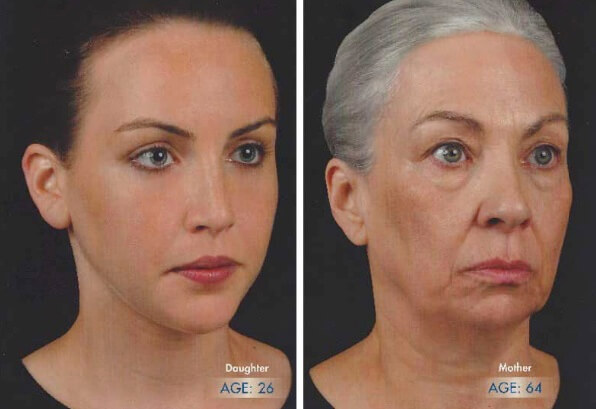
This mother-and-daughter comparison shows the squaring of the face during the aging process.
Not only do skin laxity, loosened muscles, and stubborn fat cells change the overall shape of the face, but they can also impact the look of the neck and obscure a formerly welldefined jawline and neck region.
Some patients turn to lasers, injectables, or other devices and treatments to address these changes, but a facelift remains the gold standard. Advanced techniques that have been developed over recent years have become available to make this type of cosmetic surgery safer and more eOective than it was in decades past.
Simply put, a facelift with the experienced Dr. Cross will help to “turn back the clock” by addressing multiple signs of aging on both the face and neck. Whether making changes to the mid portion of the face, the neck, or both, surgical correction via facelift surgery will restore tissues to a more youthful position, secure them under the surface of the skin, and remove excess skin and fat for truly transformative results.
To summarize the possible results, a facelift helps define the jawline, create a more contoured neck, and restore lost volume in key areas of the face, as seen in these patients:
*Results May Vary
Before & After Photo Gallery
See for yourself the patient transformations that can be achieved by Dr. Cross and his team.
SCHEDULE A CONSULTATION
Schedule a consultation to discuss facelift cost, results, and more in Philadelphia by calling Cross Medical Group at (215) 561-9100 (Philadelphia) or (610) 688-9100 (Villanova), or send a message online.
WHAT MAKES A GOOD FACELIFT CANDIDATE?
There is no specific ideal age to get a facelift, although there is a range that particularly good candidates for the surgery tend to fall into. While it is common for women and men between the ages of 40 and 60 to choose facelift surgery, those who fall outside of this age range may also be good candidates for the procedure—and be quite pleased with their results.
Patients who work with Dr. Cross for a facelift when they are in their 40s, 50s, and even into their 60s can expect that they will continue to look better than they did prior to their procedure for the next 15 to 20 years. Older patients can also enjoy beautiful results, but it should be noted that due age-related thinning of tissues that need to be lifted during a facelift, anyone in their 70s or 80s should not expect the same longevity of results. Still, a facelift can help patients in this window to look younger than their age for a decade or more.
EXPLORE DR. KEVIN CROSS'S SOPHISTICATED FACELIFT TECHNIQUE
Dr. Cross developed his facelift techniques over decades of careful study, work, and application. His ultimate approach not only addresses the skin, but also involves work on stronger tissues below the surface. This correction strategy allows the tissues to sit naturally after the surgery, preventing them from appearing overly tightened or unnaturally pulled. They will remain in this position for many years, providing the ongoing benefits of youthful contours.
Another technique designed to maximize balanced facelift results involves Dr. Cross controlling the important muscular layer at all levels of the face, from the neck to the cheek region. When necessary, he will also manipulate this layer into the forehead, as shown in the diagram. This allows him to focus on each individual region, as well as to balance each of these regions with the others, depending on what the facelift patient's needs and desires require.
Dr. Cross will choose one of his many advanced technical options in order to create the most dramatic, but still natural-looking correction possible.
See the results of Dr. Cross' techniques in his facelift before-and-after photos. Browse the facelift before-and-after gallery online or ask to see images of his past patients—including mini-facelift before-and-after photos—during your consultation.
As Dr. Cross tells his patients, "A good facial rejuvenation should mean that, once the recovery is complete, friends and family will appreciate an improvement, but a new acquaintance should not know that a procedure has been performed."
DEEP PLANE FACELIFT DETAILS
Widely considered to be a gold standard in the field of facelift surgery, the deep plane facelift technique allows Dr. Cross to mobilize and reposition all of the aging elements of the face, including skin, muscle, and fat. This is most essential in patients whose cheeks have deflated, who have developed deep nasolabial folds, and who have seen excess jowls develop and obscure their jawline.
Dr. Cross puts all of the tissues and layers back where they belong after releasing tethered ligaments in the face. These ligaments can only be released from a deep access point, which requires a maneuver that is key to every successful deep plane facelift surgery procedure. These same ligaments prevent many standard facelifts from achieving rejuvenation in the midface and jowl area, because when they are not released, they prevent the appropriate repositioning of the tissues in the area. The result of a less-sophisticated approach is less natural.
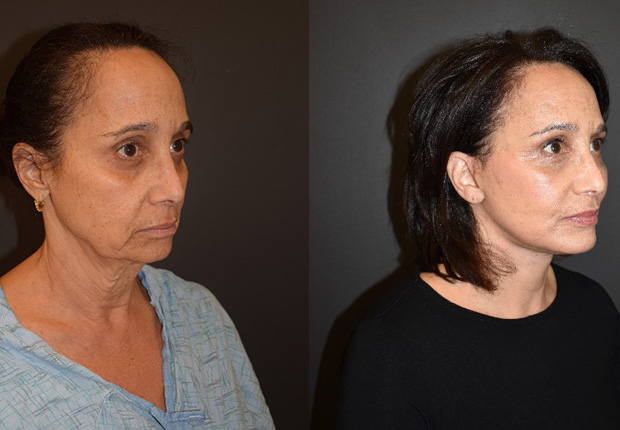
Notice in this picture of a 63-year-old woman who underwent a deep plane brow, face, and neck lift, that the sagging in her cheeks has been lifted. Her features are no longer flat and square, but take on the more curved shape of youthfulness. Her cheeks are higher and more full, and her jowls are corrected.
HIGH SMAS FACELIFT DETAILS
The so-called “High SMAS facelift” is very similar to the deep plane facelift, with the main difference being that the deep entry point is made higher on the face. This allows even more improvement in the cheek region and is an ideal option for younger patients, as well as those with a naturally thicker SMAS—which stands for superficial musculoaponeurotic system, a fibrous network that provides support for facial muscles. Part of the artistry in face lifting is being able to recognize who is a better candidate for one procedure as opposed to another. Dr. Cross’s extensive work with patients from all walks of life and all over the world allows him to reference and access the countless variations that exist, all of which can inform the next surgery he performs.
OTHER SMAS FACELIFT DETAILS
Suturing the SMAS without first lifting the layer of supportive tissue is the most common approach used by plastic surgeons who are getting comfortable with facelift surgery. While this technique is very limited in its ability to improve shape in the mid portion of the cheeks and face, Dr. Cross will sometimes use it—especially when patients require more attention in their neck and only limited correction around the jowl and jawline.
FACELIFT INCISION PLACEMENT
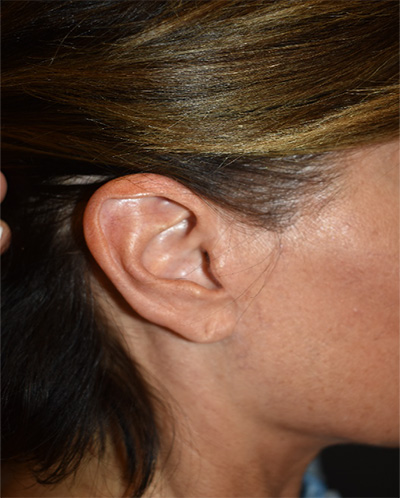
A key factor in any successful facelift surgery is incision placement. It is a common understanding that the incisions must be kept as short as possible—while still allowing the surgeon access to the necessary layers and structures beneath the skin—in order to minimize scarring. What is even more important, however, is that the incisions remain as unobtrusive as possible. The goal is that they won’t be noticed once they have healed. Incisions that distort the sideburns or that are visible in front of the ear—even if they are short or small—should not be tolerated.
Dr. Cross has noticed that plastic surgeons often shorten their incisions, but still leave the skin around the ear and neck with a puckered and bunched appearance. As is evident in the photograph here, when the incision is positioned correctly, it is nearly impossible to see—even when the hair is pulled back.
MALE FACELIFT DETAILS
The advanced facelift techniques Dr. Cross uses can benefit any patient, but there are a few important elements of a facelift that are unique to men. This largely has to do with the growth of facial hair—and especially the beard. All men have a patch of hairless skin that sits between the ear and the beard hair that grows on the cheek and neck. When lax skin is excised during a facelift and/or necklift surgery, skin that grows beard hairs is moved into the location where the hairless patch used to be. This can result in an unnatural appearance. Not everyone may recognize exactly what looks wrong, but the uncanny appearance is noticeable nonetheless.
Male patients working with Dr. Cross for a facelift can expect him to avoid this less-sophisticated result by removing as many hair follicles as possible from the skin that moves to cover the area around the ear after the surgery. This extra step is vital, but is rarely performed by facelift surgeons despite the fact that it can be very helpful to minimize any evidence that a male patient has had a facelift or neck lifting procedure.
On the subject of beards, men should also be acutely aware of numbness in their facial skin for the first few months after their facelift surgery. This is very important, because when they shave, they will feel less tactile feedback from the razor. In order to avoid lessthan-ideal results—or even a nick or cut—shaving will require a little more attention until the sensation returns.
WHAT IS RECOVERY LIKE AFTER FACELIFT SURGERY?
The exact recovery timeline for a facelift depends on which surgical technique Dr. Cross employs, the extent of the facelift surgery itself, and the individual patient’s unique healing capacity. Patients often ask Dr. Cross and the Cross Medical Group team about what to expect from facelift recovery. Every patient's experience will be their own, but regardless of what type of facelift strategy is chosen—mini, deep plane, or other—everyone can generally expect some degree of temporary bruising, swelling, and redness in the incision areas. These effects can last for two to three weeks after the surgery, but will resolve on their own.
Downtime after a facelift is similar in terms of each patient’s unique experience. Those who have had a facelift are often ready and able to get back to their typical activities within a couple of days of their procedure. They are able to go for long walks almost right away and are showering and washing their hair and face after just two days. Patients typically feel comfortable running errands, like going to the store, after about 10 days—and that’s without anyone noticing that they recently had a procedure.
Despite the quick healing possible after a facelift, some patients may not want to return to work or other activities where socializing is expected until they are able to hide the fact that they had a procedure done. This typically takes about two to three weeks, although it can take anywhere between eight to ten weeks for the surgical results to fully “settle.” Some people heal more quickly than others, but no matter a patient’s individual abilities, it is vitally important to get plenty of rest and take care of the incision sites while they're healing during recovery. Keeping incisions out of the sun can prevent the darkening and damage possible with exposure to ultraviolet radiation.
WHAT ARE REVISION AND REPEAT FACELIFTS?
As a highly sought-after plastic surgeon known for especially natural-looking results, Dr. Cross performs a significant number of revision procedures each year. These are essentially “fixes” to other surgeons' work. In fact, more than 20 percent of the facelift procedures Dr. Cross performs are revisions.
Common reasons for revision work include obvious scarring or poor incision placement, lack of improvement or rapid loss of improvement in the areas corrected by a previous facelift surgery, and an asymmetrical or imbalanced appearance resulting from the original procedure. To anyone not satisfied with their facial surgery results, Dr. Cross encourages waiting at least one year before pursuing a facelift revision procedure. That said, for some patients, a correction may be performed sooner.
It is also important to note that even ideal facelifts with beautiful results won't last forever. The reality is that the aging process will continue—and will do so starting the very second Dr. Cross puts in his last stitch. As long as time exists, it is likely that repeat facelifts will exist as well. Whether one of Dr. Cross' patients who had a procedure more than a decade earlier is seeking to rejuvenate their contours once again, or a patient who had a procedure with a different surgeon years in the past is looking for a new plastic surgeon to work with, follow-up facelifts are not only possible, but very effective.
Patients who had a facelift in the past will often find that they heal faster and more easily after their more recent facelift, mainly because techniques and technology have improved significantly over the years. Shorter scars are now possible, and a prior patient’s body is also more prepared to heal from the surgery since it has already gone through the procedure in the past and essentially knows what to expect.
When significant work is necessary on the neck region in combination with face work, a small scar under the chin is used. Many people have scars in this location from having fallen as a child, and this facelift scar appears no diOerent. In fact, it is usually quickly forgotten by the patient.
Often, patients look at pictures of their younger selves and notice that they once enjoyed more upper facial volume. When necessary for the right candidate, Dr. Cross adds volume back to the face by repositioning the natural facial tissues. The eOect can further be enhanced with fat and stem cell grafting performed at the same time as the procedure. Any volume added should not create an “overfilled” or “overdone” look, but should instead complement the overall restoration, as demonstrated in this patient:
*Results May Vary
Before & After Photo Gallery
See for yourself the patient transformations that can be achieved by Dr. Cross and his team.
FACE SURGERY AND REJUVENATION OPTIONS BEYOND A FACELIFT
Patients who want to address signs of aging that have developed on the lower portions of the face also often want to correct signs of aging that have developed elsewhere—such as on the upper face—as well. A brow lift raises a hooded and drooping forehead, while a blepharoplasty procedure (also known as an eyelid lift) creates a more alert look by opening up the eyes. Patients who want even more facial definition may opt for chin and cheek implants to make the features appear more prominent.
All of these facial surgeries alter contours, but different strategies are needed to improve cosmetic issues like crepiness and irregular pigmentation. As Dr. Cross says, surgery changes the quantity, but not quality of your skin. With this in mind, he offers a wide range of treatments, including broad band light (BBL), radiofrequency (RF), and fractional laser skin rejuvenation treatments, chemical peels, microneedling, and more.
SCHEDULE A CONSULTATION
Contact Cross Medical Group for facelift surgery in Philadelphia at (215) 561-9100 or Main Line's Villanova (610) 688-9100. You can also send a message online to inquire about a consultation, or for more information.









